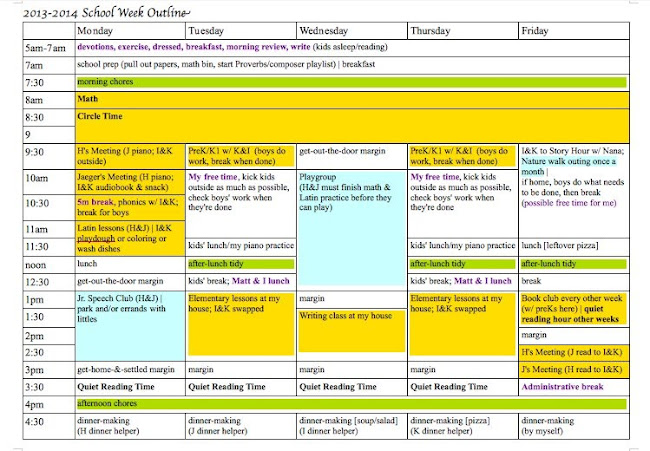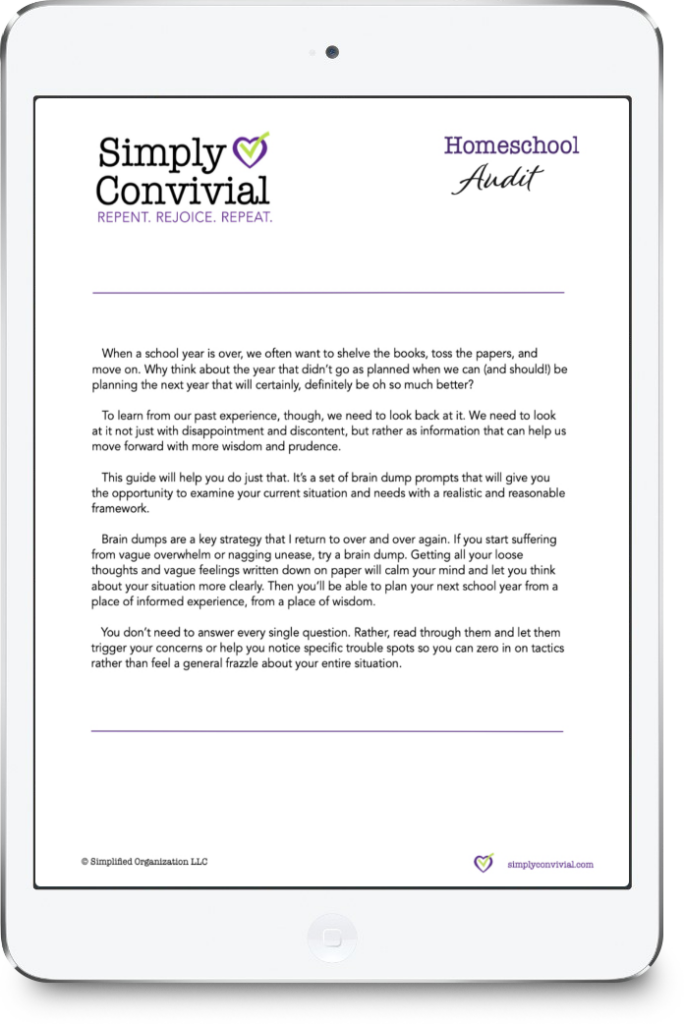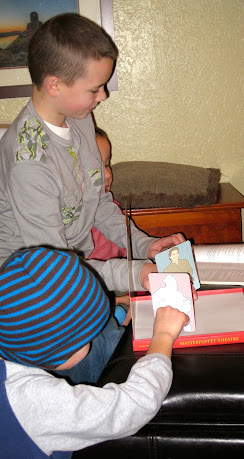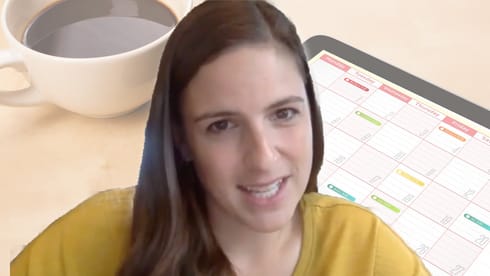Homeschool Hits & Misses

A record of our 2013-2014 school year.
It is tempting, this time of year, to skip right to discussing next year’s plans and leave this year we are wrapping up in the dust bin of forgotten memories.
But we can’t adequately plan for the next year without pausing the evaluate what did and did not work this year. How our students have grown, how our students need to be challenged next, this is information that comes when we take the time to look back and assess how things went.
First, let’s start with what the plan had been at the beginning of the year.
The plan at the beginning of the year
To keep my inner optimistic idealist at bay, I limited myself to 3 goals, 3 priorities, for this year. These aren’t SMART goals. They are still rather idealistic, but they are also abstract.
The point, after all, is developing these people along these lines, not accomplishing the goals regardless of the person. These are our priorities for the year. If something happens and things fall apart or if some new shiny option presents itself, these are the filters for our time this year.
Because one overarching goal is encouraging lifelong learning, which I as the teacher must model if it will be taught, and because I have the privilege of living a home educating life, I get three educational goals for myself, as well.
Myself, 31-years-old
- Undertake diligent reading, including SWB histories & good progress on TBR piles. Specific goal: 52 books in 2013, 75 books in 2014.
- Begin self-taught piano lessons, finally.
- Build the habit of writing daily.
Hans, 10-year-old
- Practice good expression: orally, in writing, in conversation, and in Latin. (trivium)
- Progress through math & music as mastery is achieved. (quadrivium)
- Grow in self-discipline, work ethic, and responsibility.
Jaeger, 8-year-old
- Practice good expression: orally, in writing, in conversation, and in Latin.
- Progress through math & music as mastery is achieved.
- Grow in self-discipline, work ethic, and responsibility.
Ilse, 5-year-old (6 in January)
- Work on reading as developmentally appropriate.
- Work on math as she masters lessons and wants more.
- Foster her faith one-on-one (Bible stories, conversation, Scripture memory, doctrine, catechism).
Knox, 3-year-old (4 in February)
- Reliably potty trained.
- Be read aloud to daily.
- Memorize Psalm 1 and the catechism at least through Q&A 20.
Geneva, 1-year-old (in November)
- Hear Scripture and other good language (read-alouds) daily.
- Be loved.
- Grow.
The Planned Schedule

A note on the color coding: yellow is school times, blue is times out of the house, and green is housework time.
This is the overview schedule, not the detailed sort with a column for each person, but it is enough to give a picture of the flow of the days. Things like nap time isn’t on there, because there just really isn’t such a thing anymore at our house. None of my children have been good (i.e. long) nappers, and a baby’s routine changes so often that it’s not worth planning on, in my opinion and experience.
The baby (who will be 9 months when we begin and 18 months when we finish) will simply be juggled through the day: When she naps, I’ll either focus better on whoever I am with or I will send the others off and shut myself in my room for a brief moment of peace and quiet; when she’s awake, she’ll nurse and be on my lap or eat berries and apples and beans in her chair or play on a blanket on the floor or be contained in the exersaucer.
Perhaps I might even be adventurous enough to sometimes take lessons outside and let her wonder in the yard when she starts moving. I’ve never yet homeschooled without juggling a baby or toddler in the mix, so I don’t really worry about it anymore.
We’ll just muddle through and make the best with however it plays out. I’ve never had success in trying to schedule a baby to be convenient, and I’ve given up trying. Babies always change right after I figure out how to manage their current stage.
Besides, the language exposure is good for them, right?
We’ll see, too, if we can take advantage of my husband’s new work-from-home job and have a short in-house “lunch date” after the kids’ lunch and while they get a play break.
I don’t schedule the boys’ reading time, because I haven’t had to yet. They choose to read, though the amount ebbs and flows – as it does for me. They will be reading, probably on average about 1-2 hours a day, but it’ll be on their terms and fit around other opportunities or inspirations. My oldest two are natural readers, so I recognize this freedom might not be possible in the future for all the children, but right now it works just fine for us.
An end-of-year audit
What are plans, though? The real question is what happened to those plans when they hit real life. Here is my assessment of the school year after these plans were (somewhat) implemented.

HOMESCHOOL AUDIT
Make next year better based on how this year went.
Download the free homeschool audit and use this year’s experience to make next year better.
Math
I still love Math-U-See. Hans completed over a book and a half, which when paired with his more-than-one-book progress last year, brings him up from “behind” the book number matching his grade. So, my trust in their system and the mastery approach is paying off. Jaeger, though two years younger, is only one book behind him, so math appears to be his strong suit.
I did use some Calculadder for math facts review, but also decided this last month that xtramath.org is simply the best method for fact mastery.
Language
This year the boys were in a speech class which was stretching and very good for them. I also am teaching a writing class for Hans and Jaeger and some of their friends. Their writing ability has improved greatly this year with the sustained attention being given all year. Latin lessons, however, got mostly ignored when the speech and writing homework took all the one-on-one time and energy I had.
Morning Time
Our memory work binders continued to make Circle Time much smoother and easier to pick up and start. I also had to remember to charge my iPod most evenings so that I’d have the battery power to facilitate our singing, and that’s now nearly a habit. :) I think we are now over the difficult stage of Circle Time – the older boys are won over and it is nearly a habit.
Everyone feels it when it’s missing from our mornings. Having older ones on board, carrying on the show when little ones need to be dealt with, is a huge help. But sticking it out until we got to that point is how we got to that point. So, if you’re still in the “winning them to it” difficult stage: Stick to it! It will pay off!
Content Areas
We finished books 2 & 3 of Covenantal Catechism, covering the Old Testament and how God kept His promised line to Christ despite sin and Satan. We read all of The Story of the Middle Ages and got a start on The Story of the Renaissance and Reformation. We did most of Young Peacemakers, but didn’t quite finish. We also read A Child’s Geography: Explore His Earth (we didn’t do any of the activities).

We saw 2 live Shakespeare plays (Hamlet & Midsummer Night’s Dream) and watched 2 Shakespeare movies (Taming of the Shrew & Henry V). We listened to audio performances of Taming of the Shrew, Midsummer Night’s Dream, and Henry V, and the kids acted out their favorite scenes with finger puppets. Shakespeare this year was simple and a huge hit, so I’ll write a post of its own for that.
Of course, wide and varied free reading covered a lot of bases for my 10 & 8 year olds. I plan on making several book list posts over the summer, so I won’t go into that now. I didn’t assign any particular books.
I just stocked the shelf with medieval biographies and stories (including Arthurian legends) and they’ve all been read multiple times in the course of a year.
We (my friend and I who do school and life together) also bought real nature journals for the kids and we have done 3 or 4 nature walks (we’ll do some while we’re on break, too) and a hand-full of backyard nature observations, too. It doesn’t sound like much, but it’s an improvement on previous years, so I’m putting nature study in the “success” category.
Schedules & Organization
A huge secret to our increased consistency and amount of material learned this year was scheduling things with other people. So, speech class happened because there was money out for it and an appointment on the calendar. Writing class happened because people came to my house and paid me money to teach it.
Elementary lessons happened because 2 extra kids showed up at my house at 1pm every Tuesday and Thursday and my friend stopped by to pick up my preschoolers. So the preschoolers got an hour of picture books those days (something I just never do, to my shame) with my friend, and we worked through Bible and History and Science at my house.
I was way more consistent because I committed myself to people other than myself. :)
Putting together all the materials in specific homes worked really well for us this year, too. I straightened them all up each break week and they are still going strong at the end of the year. I love file boxes (not crates).
And I am more and more in love with the 6 weeks on, 1 week off model of year-round homeschooling. Absolutely worth it to start in July to have those breaks in February, October, and to be done in May!
Good Signs That Education Is Happening

Some books for next school year arrived and Hans browsed them while sorting them into piles. He commented: “I feel sorry for my friends who think reading is part of school work. I think reading is for fun.”
MISSION ACCOMPLISHED.
What did not work this year.
Of course I’m already thick into planning out our next homeschool year, but pausing to reflect on the year we’re just wrapping up is an important part of planning for the next year. The only way to know what to add, what to remove, and what to tweak, is to know what went right and what went wrong this previous year.
I’ve already written about what went well this year, so now it’s time to talk about what didn’t work well for us.
Less Quiet Time
This year was the first year we did not have quiet time in the afternoons. We had something every afternoon during the baby’s nap time. So, the baby got a nap, but the rest of us were not only working, we were working with other people in a class setting.
After that time was over, then, the baby was up, the younger set were anxious to run around noisily, and neighborhood friends were ready to play. Myself and my two oldest are introverts, and it wasn’t until early spring, when one of these classes ended, that I realized that we were just worn down from having much more social interaction and not having any recovery time afterward.
So in our schedule for next year, I have reserved 3 afternoons a week that are going to be quiet reading and notebooking time. We survived this year, and could make it again if it was required, but we introverts need quiet for energy recovery if we’re going to thrive, so I am going to prioritize making that happen regularly.
It was also the first year that we had a five day school week instead of a four day week. Previously, we took Mondays off as our day for errands, appointments, field trips, and cleaning up the house after weekend entropy.
I did not anticipate how much not having that house-recovery time would affect me and my ability to keep up with house routines and errands. Somehow there has to be time set aside for catching up around the house, for going to the grocery store, and for taking care of the incidentals that pop up. Just leaving them to fit into the margins means there really is no margin and the only way to get to house chaos is to take a day off.
I am still not sure how to adjust for that, because I don’t think we can do a 4-day school week anymore. But I am going to take a hard look at that assumption and also make house and life recovery time a block that gets weekly attention one way or another. Assuming these things will just happen “some time,” but not leaving or making time for them, is a sure way to think the day has margin when it is actually full-bleed.
Less Latin
We got through just under half a book each for Hans (finished Primer A, into Primer B) and Jaeger (Primer A), but we only did Latin about half our weeks. So when we were doing Latin, we were making good progress and it was simply my dropping the ball and not difficulty that kept us from Latin.
Speech and writing classes took up more independent and one-on-one time than I anticipated in my plan, and on top of that, Latin required the most out of my own brain and energy to keep us going, so I dropped it like a hot potato when I felt like I didn’t have it in me (apparently, this was about half the time).
We aren’t doing speech next year and I still have decisions to make about how to approach writing, but I’m moving Latin up the priority chain. The good news is, both boys usually enjoyed doing it and wanted to do it, so it really was all on me that it didn’t happen. I’m wasting great potential if I continue to postpone their enthusiastic requests for Latin because I’m not in the mood.
Handwriting Fail
So, my oldest nearly 11 and my second son is nearly 9. They can’t do cursive. They start several letters from the bottom. They write a b by starting at the top and looping around from the bottom. I cringe and feel guilty when I watch them write.
They do, at least, hold their pencils correctly.
But, both of them love to draw and have been copying letters ever since they were 5 and 4 – and no 5-10 minute handwriting lesson was going to fix the habits they picked up on their own. I could correct their pencil grip with a hawk’s eye in the midst of life, but couldn’t (or didn’t, anyway) watch their letter formation vigilantly. I am undecided about how much energy to put into teaching them cursive or correcting their incorrect letter formations.
However, I still have 3 children left whom I haven’t yet failed in this regard. So I have vowed to myself that I will at least try with them. That means no skipping handwriting as an easy out for my 6-year-old and 4-year-old. The 6-year-old has only just started copying on her own, doesn’t do it much, and is much more keen on doing things “right.”
Inconsistency
Always, right? Will there ever be a year where I don’t list this as a failing?
Both my older sons have requested for the next school year that we actually do Monday meetings every Monday and that I put up our day’s plans on the white board every day instead of only once or twice a week.
They really enjoyed having their own checklist and plan where they could write what was happening that week and what they wanted to accomplish (they each picked a book and listed a goal or project if they had one). We did pretty well with them until Christmas, and just never got into the swing of it again after the new year.
Again, they enjoyed and wanted it, and it was all me dropping the ball.
So, can I make “not dropping balls” a goal for a year? Perhaps it would be better to determine to keep up the important balls dropped this year and drop different balls next year.
The important thing in looking back over the failures of a year gone by is to learn from them without getting stuck in them or stuck in the seeming futility of trying. Review the “successes” list again. And, look for the hidden successes and blessings even in the flops; they’re there if we’re willing to get over ourselves and credit them.

HOMESCHOOL AUDIT
Make next year better based on how this year went.
Download the free homeschool audit and use this year’s experience to make next year better.


